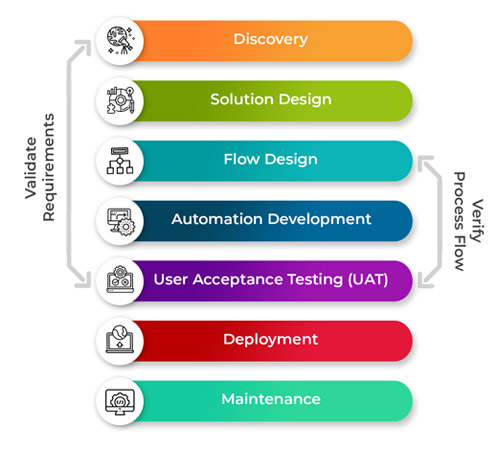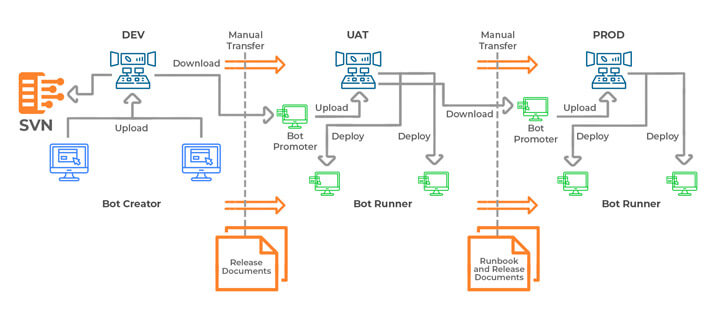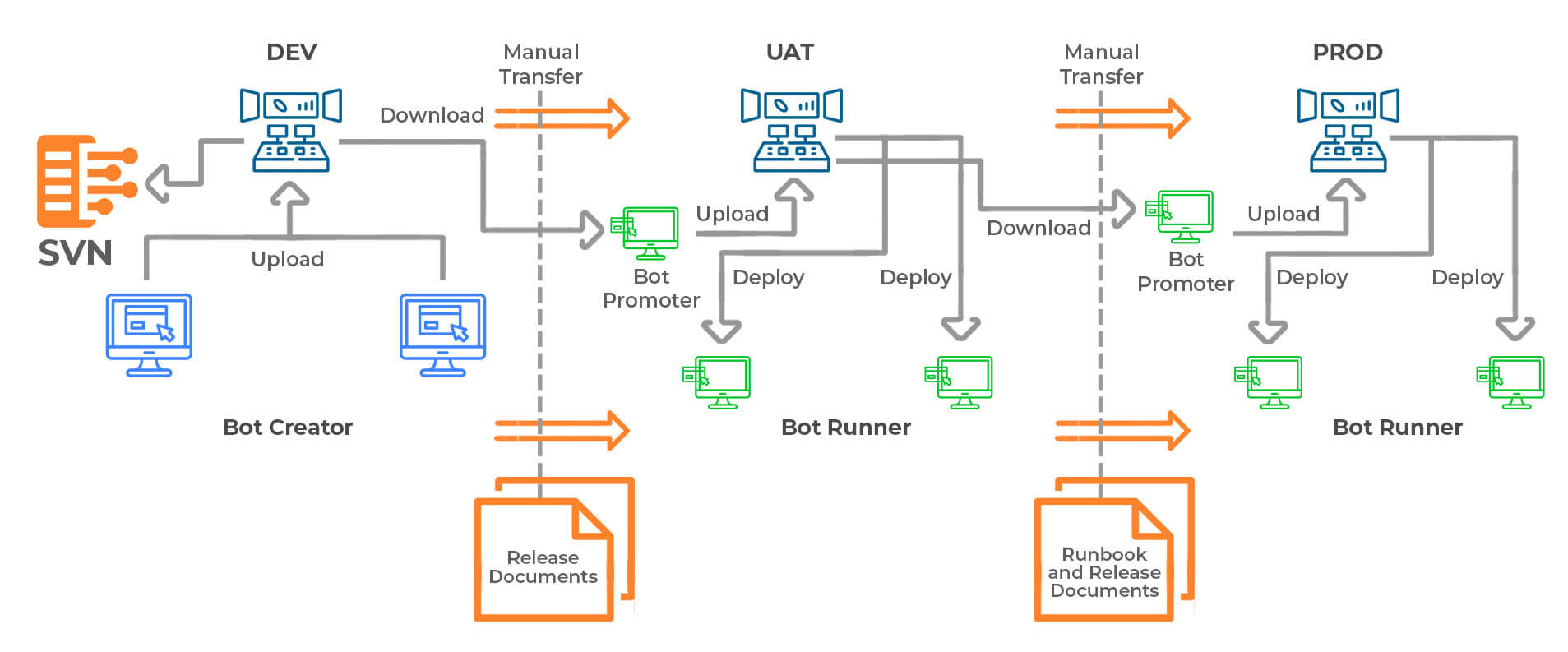Software Bots work 24*7*365 with high accuracy and efficiency, this increases the productivity, and helps achieve prodigious results”
Silver Touch Technologies executes the RPA Projects following Agile Methodology. We create the project plan including Sprints. Schedule is sub divided into a series of sprints each running for a specific time period varying from 8-10 weeks. Sprints cover complete Bot Development Life Cycle (BDLC) phases, including Business Analysis, Design & Development, Testing and UAT, Deployment, Maintenance.
Each sprint has three automation engineers working as group or Bot Creator Group (BCG). Each Bot Creator Group can automate 4-6 processes in one sprint. Thereby if a sprint has two Bot Creator groups, can automate 8-12 processes. Apart from Bot Creator Groups (BCG), Sprint Team includes other resources, who are responsible for the sprint development. Following resources will be working with more than one Bot creator group in single Sprint.
Approach for RPA


Discovery
During this phase typically a couple of weeks, Silver Touch Business Analysts understand the process to be automated. Meetings are conducted with SMEs or Business Process Owners and a detailed AS-IS Process document is prepared by the Silver Touch BA and submitted to Business Process Owner. During this phase interview will be conducted with various stakeholders/process owners to understand the workflow, documents involved, data format, applications used, technological aspects, systems, data volume, frequency, manual interventions, decision making, and so on.
After this extensive knowledge sharing, the Business Analyst prepares the AS-IS document, Reviews it for feasibility with RPA Technical Team and submits to the Business Process Owner. All exceptions, constraints and the known errors are explained and listed in the document. After thorough review and acceptance of current process understanding the Business Process Owner, signs off the AS-IS Process document. AS-IS Process document sign off from the Business Process Owner leads to the happy path and the development phase starts.
Bot Design
RPA Solution Architects play a very important role in Bot Design Process. RPA Solution Architect’s analyzes the As-IS Process and develops proposed design for the process To-Be developed along with High Level Bot Design /solution design. Solution Architect prepares Bot Solution Design document and it is discussed with the Business Process Owners at Client side for any chance of challenges occur during the implementation of the RPA due to dynamic data interference like input values, OTPs or code words etc.
Silver Touch Technologies-RPA team follows below list of best practices during RPA Implementation / Bot design:
- Silver Touch follows standard structure to maintain Bots with Master Bot along with multiple sub-Bots to ensure modular structure of Bots for quick access
- Concept of Master Bot to execute logically multiple Bots
- While developing Bots, we generally follow the concept of reusability. So we develop reusable components and Silver Touch maintains a common repository for functions like login, error-handling
- Bots not only follow the Happy Path, but also take care of the Exceptions during execution. Silver Touch ensures that these Exceptions are informed to the Business Process Owners, in if they are to be attended manually
- Silver Touch ensures that the Bots are designed in such a manner that they can handle high voluminous data or transactions as per the statements in SLAs defined at Client’s process. While handling high volume transactions, Load Balancing concept is applied and parallel runner machines handle the execution
- We ensure that we are well informed of the changes are predicted in the to-be process in dialog with Business Process Owners
- Silver Touch Works together with Business Process Owners to design the to-be process if any changes are predicted in the flow of the business process/ and its associated applications
Bot Development
RPA Implementation Deliverables are created during Bot development process:

Automation Bot Creator Groups (BCGs) (group of three automation engineers) work with Solution Architect and BAs to understand the process & Bot design and develop Bots as defined in the AIP document for listed requirements. We develop end-to-end business solutions using the combination of RPA and Artificial Intelligence.

RPA Coding Best Practices at Silver Touch
- Uninterrupted Code during migration process of Bots from DEV to UAT and from UAT to Production using Configuration File which resolves the environmental issues and smooth transition of Bots.
- Code is well commented for easy understanding to peers /SAs or Technical Program Managers
- Log information is useful for routing the analysis like service Start/Stop, configuration assumptions and successful initialization etc.
- Further we manage process logs and technical logs for SMEs and RPA Engineers for action.
- In Bot Development process we follow standard naming conventions for folder structure, variables and the configuration files, all input and out files. This convention is followed throughout the Bot Development Life Cycle.
- Error logs indicates about the critical things that had occurred. The error logs should indicate relevant stakeholder regarding the problem faced during that transaction/event
- Error Handling: We make sure that all errors are handled with expertise. The errors are handled at two different levels:
- Complete Error handling code under Error Handling Block
- Define individual Error handling Blocks in each Bot
- We use AA Credential Vault for security aspects. We use encrypted credentials or confidential data that requires security
Bot Deployment
Final and concluding phase of the BDLC, Bot Development Life Cycle is the Deployment. We consider deployment at an early during the development process there by avoiding delay in implementation. This practice ensures smooth transition of Bots from UAT to Production environment. Once the UAT is completed and checks for Production readiness. Testing is Production environment is carried out followed by deployment in Production environment.
Bot Journey from UAT to Production
- Bots are tested in UAT environment before moving to Production. UAT team has to Sign Off the process
- It is ensured that the Bots work independent of Environment during DEV phase and Coding Guidelines are followed strictly to avoid any hard coding dependencies
- Code Review best practices are followed
- All message boxes, pop-ups and other display windows that are added during DEV are removed and it is ensured.
- All File and Application paths are tested for access
- Access to all applications and Systems is acquired for smooth deployment
- Ensure that all Runners are tested for access of required applications and
- Make sure that all required Applications are installed on Runners before first production run
- Checklist/Log for Production Support is ensured and Production handover meet is scheduled in line with all stakeholders
- Final Review of BoT Execution and RPA Project closure with Business Process Owners in coordination with BAs & Technical Program Managers
Become RPA Developers Get trained by our Certified RPA Experts!
Precautions on Production
- Bot Dependencies are checked and mapped during Migration from UAT to Production
- Production support team is informed during the handover meeting
- Production Support Team is involved in first Production Run
- Designated Bot Runners /Executive schedule the bots only for maintenance purpose
Bot Maintenance
After moving to the Production, RPA techno-functional support team takes care of:
- Production Support for Bots in Live/Production environment for specified time as mentioned in the contract
- Takes care of trivial enhancements to the Bots



